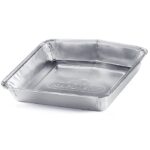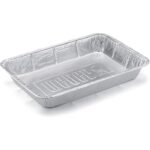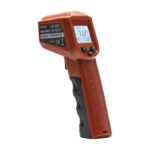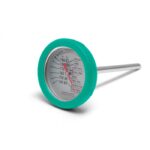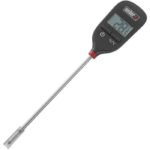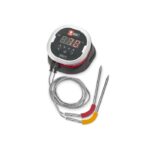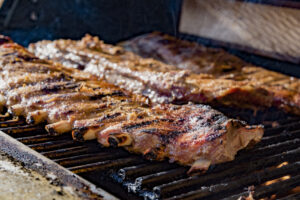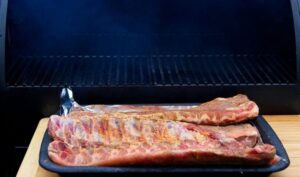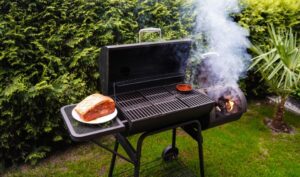For beginners, especially those using a gas or charcoal grill instead of a dedicated smoker, managing the low temperatures needed to smoke food properly can feel like the toughest part of the job. Learning how to dial in steady heat is the secret to low and slow cooking – the classic smoking technique that transforms tough cuts into tender, smoky perfection.
In this post, we’ll walk you through heat management tips for slow cooking on a gas grill and how to slow cook on a charcoal grill. From setup to temperature control, we’ll cover the tools, techniques, and best practices you need to keep your cook low, slow, and full of flavor – no matter what kind of grill you’re working with.
Let’s get grilling.
Slow Cooking on a Gas Grill
The key to slow cooking on a gas grill is to create a two-zone fire, giving you both direct and indirect heat zones. This setup lets you generate smoke on one side while your food gently cooks on the other. Watch our video to learn how to set up your gas grill for low and slow cooking, and keep reading below for detailed, step-by-step instructions.
How to set up a two-zone fire
To get started, turn on one burner (usually the far left or right) to high heat. This is your direct heat zone, where you’ll place your smoker box or wood chips. The other side of the grill becomes your indirect heat zone, where your food will sit during the cook. This setup lets your meat cook slowly without being exposed to direct flames.
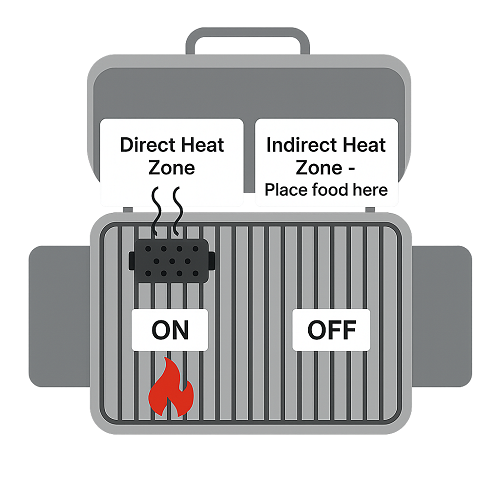
Manage your temperature and smoke
Here’s the trick to smoking and slow cooking on a gas grill: you need enough heat to get your wood chips smoking, but not so much that the whole grill gets too hot for low and slow cooking. Wood chips typically need to hit 570°F to start smoking, but low and slow cooking calls for temperatures around 250°F.
To get that perfect temperature, begin by placing your chips over the high-heat burner in a smoker box – cast iron works well because it retains heat and keeps the chips smoldering consistently once you lower the heat. Once your chips start smoking, dial down the burner. When the temperature drops close to your target (250–275°F), close the lid so the smoke can build up inside the cooking chamber. Your goal is to maintain a steady grill temperature between 250–275°F in the indirect zone.
Use a grill thermometer placed on the cool side of the grate to monitor the temperature – don’t rely solely on the built-in lid thermometer, which measures the temperature at the top of the cookbox.
Adjust based on your grill’s burner layout
Gas grills vary, so your exact burner setup will affect how you manage heat:
- 2-burner grills: Turn one burner on and leave the other off. Cook your food over the unlit side.
- 3-burner grills: Start with one burner on high, and adjust the middle burner if needed to balance the temperature.
- 4+ burner grills: You may need to experiment. Start with one burner on high, then tweak the adjacent burners to fine-tune the temperature on the indirect side.
It may take a little trial and error, but once you find your grill’s sweet spot, slow cooking on a gas grill becomes a reliable and delicious way to barbecue.
How To Slow Cook on a Charcoal Grill
Creating a two-zone fire is also key to slow cooking on a charcoal grill.
Unlike gas grills, where you control burners with a knob, charcoal grills rely on how you arrange the coals. With the right setup, you can maintain low temperatures for hours without constant babysitting.
Watch our video to learn how to set up your gas grill for low and slow cooking, and keep reading below for detailed, step-by-step instructions.
Building your two-zone fire
The most common way to create a two-zone cooking setup on a charcoal grill is to pile your coals on one side of the grill to create the direct heat zone. The opposite side, where there are no coals, becomes your indirect heat zone – perfect for low and slow cooking.
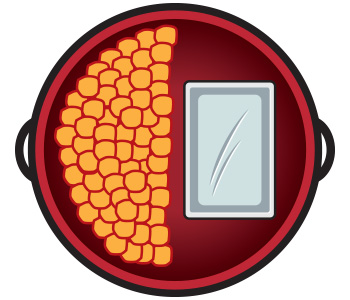
But not all coal setups are created equal. Here are a few other popular coal set-up methods that give you control and consistency:
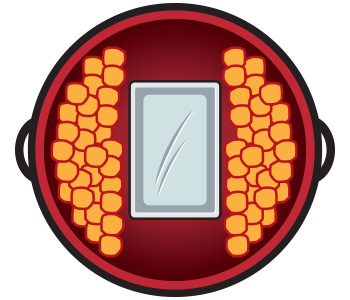
Three-Zone
With this method, the coals are spread on either side of the grill, leaving the middle of the grill empty to use for indirect heat.
For a quick and easy three-zone setup, you can purchase a charcoal briquet holder.
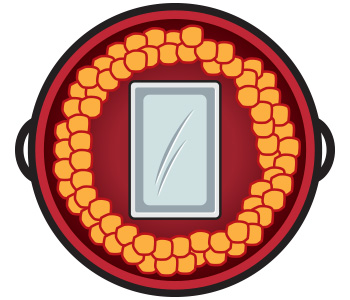
Ring Of Fire
Place your coals in a circle around the edges of your charcoal grate. Arranging your coals around the perimeter will provide direct heat while the center of the ring provides an area of indirect heat.
The biggest disadvantage to this charcoal arrangement setup is that it’s very time-consuming to position the coals in a circle formation.
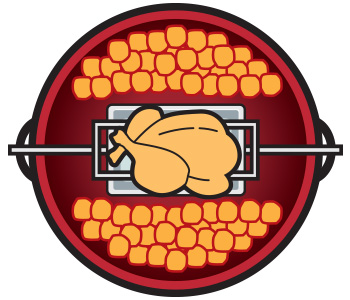
Rotisserie
Set up the coals with the three-zone setup. Then set up your chicken, turkey or larger roasting meat using a rotisserie kit.
The snake method
Keeping the heat going on a charcoal grill during longer cooking sessions can be challenging. Many grillers swear by the snake method, also known as the minion method, to keep the coals burning over 12+ hours. Here’s how to do it:
- Arrange your charcoal briquettes in a semicircle or ring around the inside edge of your grill, two briquettes wide and two high.
- Light just one end of the “snake.” As the lit coals slowly ignite the unlit ones, you’ll get a consistent burn for up to 12 hours – ideal for large cuts like pork shoulder or brisket.
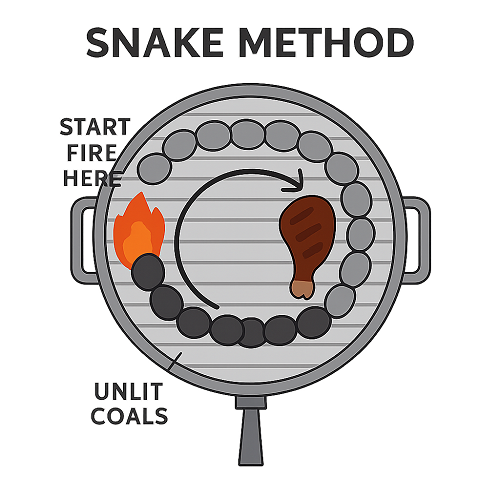
Some pitmasters also keep backup coals resting on the grill grate above the fire so they’re preheated and ready to catch quickly if needed.
See what one Reddit user had to say about this trick:
Comment
byu/Toughy99 from discussion
inBBQ
Use a charcoal chimney for refueling
You can also use a charcoal chimney to prep additional coals for longer cooks. While you can drop fresh unlit coals directly onto the lit ones, this often causes a spike in smoke and temperature, something you don’t want during a delicate low and slow session. Starting coals in a chimney gives you better control and keeps temperatures more stable.
Keep in mind that if you’re working with a smaller grill (under 18”), space might be too tight to effectively set up a two-zone fire. You’ll need to monitor temps more closely or consider cooking in smaller batches.
Controlling temperature with your vents
Once your fire is set, the next step is managing your grill’s airflow using the vents:
- Lower (intake) vent: This controls how much oxygen reaches the fire. More air = hotter fire.
- Upper (exhaust) vent: This helps draw air through the grill. Opening it increases circulation and encourages more smoke.
The experts at Epicurious have you covered on how to dial in the right temp:
"First, take a reading on your thermometer about 5 minutes after adding the lit charcoals to one side of the grill. If the temperature has exceeded that 225°F sweet spot (and it probably has), it's time to partially close the intake damper, reducing the amount of oxygen and tamping down the heat of the grill. Every 5 minutes, check on the temperature and take note of where it stabilizes. Too low? Open up the intake damper a bit. Too high? Close the intake damper a bit more. Soon, you'll discover the ideal range of notches on your intake damper that reliably deliver 225°F under most circumstances."
Once you understand how to slow cook on a charcoal grill, managing the fire becomes second nature – and the results speak for themselves.
Common Pitfalls When Cooking Low and Slow (and How to Avoid Them)
There are a few common mistakes that can throw off your results when you’re grilling low and slow. Here’s what to watch for and how to stay on track.
❌ Pitfall: Starting with too much fuel
Why it’s a problem: Lighting too many coals or turning on too many burners can cause your grill to run hot right from the start, making it difficult to bring the temp down.
How to avoid it: Always start small, especially with charcoal. Use just enough fuel to get things going, then slowly add more if needed.
❌ Pitfall: Not monitoring temperature at the grate
Why it’s a problem: The temperature on the lid thermometer can be 25–50°F hotter than where the meat actually sits.
How to avoid it: Use a digital thermometer at the grate level to track temperatures right where the food is cooking, especially when you’re working with indirect heat.
❌ Pitfall: Opening the lid too often
Why it’s a problem: Heat and smoke escape every time you lift the lid, causing fluctuations that can dry out meat or extend your cooking time.
How to avoid it: Trust your thermometer. Only open the lid when it’s time to rotate or check doneness.
❌ Pitfall: Adding unlit charcoal directly to the fire
Why it’s a problem: Cold coals smother the fire temporarily but will cause a temperature spike as they ignite, making it hard to maintain a steady low temp.
How to avoid it: Pre-light additional coals in a chimney starter before adding them to the grill. It takes a bit more time, but it keeps your temperature stable.
❌ Pitfall: Running out of fuel mid-cook
Why it’s a problem: Long cooks can burn through a tank of propane or a full load of charcoal, leaving you without fuel before your food is finished cooking.
How to avoid it: Start with a full tank or chimney, and always have a backup ready, especially for cooks that run 8+ hours.
By keeping these common issues in mind, you’ll be well on your way to mastering how to slow cook on a charcoal grill or slow cooking on a gas grill without the headaches.
Tips for Better Low and Slow Cooking
Once your grill is set up for low and slow cooking, a few smart tips can help you lock in flavor, improve temperature stability, and avoid surprises mid-cook, particularly during long smoking sessions.
1. Add a water pan or heat sink
Using a water pan in your gas or charcoal grill does more than keep the meat moist. The water helps regulate internal grill temperature by absorbing heat and releasing steam, creating a humid environment that keeps the outside of your meat tacky, helping it absorb more smoke flavor for a deeper, richer bark.
Foil-wrapped bricks or fire-safe ceramic tiles can act also as heat sinks, absorbing and radiating heat to help stabilize grill temps. This is especially useful if you’re grilling on a windy day or dealing with frequent temperature swings.
Shop for drip pans:
2. Use a thermometer at the grate level
Don’t rely solely on the built-in lid thermometer, they are notorious for giving inaccurate readings. Instead, place a digital thermometer at the grate level, right where the meat is cooking. The temperature above a lit burner might read 250°F, while the indirect side could be closer to 200°F. Measuring where it matters gives you better control.
Shop for grill thermometers:
3. Keep the lid closed
Every time you lift the lid, you release heat and smoke. Resist the urge to check too often. Trust your thermometer and let the grill do its job. Consistent heat is critical to successful low and slow results.
4. Have extra fuel ready
If you’re slow cooking on a gas grill, make sure you have enough propane. Low and slow cooks can go for 8–12+ hours, and the last thing you want is to run out of gas halfway through. Always start with a full tank and consider keeping a spare on hand just in case.
Master Low and Slow Cooking on Any Grill
Whether you’re just getting started or you’re refining your technique, mastering low and slow cooking and smoking comes down to understanding your grill, managing temperature, and staying patient. With the right setup, whether you’re slow cooking on a gas grill or learning how to slow cook on a charcoal grill, you can turn simple ingredients into something truly special.
By creating a two-zone fire, managing airflow or burners, and using tools like water pans, heat sinks, and grate-level thermometers, you’ll be able to cook low and slow with confidence. It might take a little trial and error, but once you find your groove, you’ll wonder how you ever grilled any other way.
Now it’s time to fire up your grill and give it a go … low, slow, and full of flavor.
Related Resources
Sources
- “Controlling Temperature on a Charcoal Grill“. Susie Bulloch. Last updated May 1, 2025. heygrillhey.com.
- “How to Keep Charcoal Grill at 225°F“. Becky Hughes. June 20, 2017. Epicurious.
- “How to Smoke on a Gas Grill“. bbqguys.com.
- “How To Set Up Your Gas Grill for Smoking and Low and Slow Cooking“. Dan Mikesell. September 3, 2021. 101cookingfortwo.com.
- “Turning Your Propane Grill Into a Smoker“. May 19, 2025. ThermoWorks.com.


